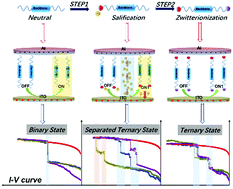The incorporation of the ionization effect in organic semiconductors assists in triggering multilevel resistive memory behaviors†
Abstract
The introduction of the ionization effect into organic small molecules could be a promising strategy for modulating their memory behaviors. Herein, two new ionic and zwitterionic D/A-conjugated small molecules (LD-IOM and LD-ZIOM) have been prepared via salification and further zwitterionization from their neutral parent structure LD, a pyridine-based molecule. Incredible blue-shifting absorptions of LD-IOM and LD-ZIOM by 44 and 88 nm, respectively, were observed as compared with LD. Molecular dynamics simulations suggest the preferential molecular packing modes of J-, Slide-H- and H-aggregations for LD, LD-IOM and LD-ZIOM, which are in good agreement with the experimental results. LD-based memory devices exhibited binary WORM-type memory performance with the probability for minor misreading, while LD-IOM and LD-ZIOM-based devices revealed upgraded ternary memory behaviors. The counterions in LD-IOM manifested an induction effect on the molecular packing orientations and caused two separate threshold voltage distributions, attributed to ion fractionation and the migration effect.



 Please wait while we load your content...
Please wait while we load your content...